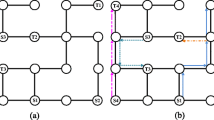Abstract
Multi-agent robotic systems are useful in many practical applications. For some tasks, such as holding a conference, cooperation among agents are necessary. For other tasks, such as cleaning a room, multiple agents can work in parallel for better performance. This paper provides help-based (HCP) and coordination-based (CCP) protocols for controlling agents to accomplish multi-agent tasks. The HCP utilizes efficient negotiation to coordinate agents into groups. The CCP improves overall performance by exchanging local knowledge among agents and making decisions in parallel. A reactive and modularized agent architecture was employed to implement the protocols. Since each protocol is embedded into the architecture, it is efficient and effective. In addition, the protocols are deadlock-free. The protocols were utilized to solve the Object-Sorting Task, which abstracts two characteristics of tasks: parallelism and cooperation. The experimental results showed that 1) both HCP and CCP are stable under different workload; 2) the protocols can effectively utilize the agent-power to achieve super-linear improvement; 3) The CCP is better than the HCP in both performance and speedup.
Similar content being viewed by others
Explore related subjects
Discover the latest articles, news and stories from top researchers in related subjects.References
Agah, A. and Bekey, G.A. 1995. In a team of robots the loudest is not necessarily the best. In Proc. of the 1995 IEEE International Conference on Systems, Man, and Cybernetics, Vancouver, Canada, pp. 3800-3805.
Alami, R., Robert, F., Ingrand, F., and Suzuki, S. 1995. Multi-robot cooperation through incremental plan-merging. In Proc. of IEEE International Conference on Robotics and Automation, Nagoya, Japan, pp. 2573-2579.
Arkin, R.C. 1989. Motor schema-based mobile robot navigation. International Journal of Robotics Research, 8(4):92-112.
Arkin, R.C. 1992. Cooperation without communication: Multiagent schema based robot navigation. Journal of Robotic Systems, 9(3):351-364.
Arkin, R.C. and Hobbs, J.D. 1992. Dimensions of communication and social organization in multi-agent robotic systems. In Proc. 2nd Inter. Conf. on Simulation of Adaptive Behavior, Honolulu, HI, pp. 486-493.
Arkin, R.C., Balch, T., and Nitz, E. 1993. Communication of behavioral state in multi-agent retrieval tasks. In Proc. of 1993 IEEE International Conference on Robotics and Automation, GA, pp. 588-594.
Asama, H., Matsumoto, A., and Ishida, Y. 1989. Design of an autonomous and distributed robot system: ACTRESS. In Proc. of IEEE/RSJ International Workshop on Intelligent Robots and Systems '89, Tsukuba, Japan, pp. 283-290.
Balch, T. and Arkin, R.C. 1994. Communication in reactive multiagent robotic systems. Autonomous Robots, 1:27-52.
Brooks, R.A. 1986. A robust layered control system for a mobile robot. IEEE Journal of Robotics and Automation, RA-2(1):14-23.
Brooks, R.A., Maes, P., Mataric, M., and More, G. 1990. Lunar base construction robots. In Proc. IEEE International Workshop on Intelligent Robots and Systems (IROS '90), Tsuchiura, Japan, pp. 389-392.
Fukuda, T., Nakagawa, S., Kawauchi, Y., and Buss, M. 1989. Structure decision method for self organizing robots based on cell structure—CEBOT. In Proc. of IEEE International Conference on Robotics and Automation, Scottsdale Arizona, pp. 695-700.
Hackwood, S. and Beni, S. 1992. Self-organization of sensors for swarm intelligence. In Proc. of 1992 IEEE International Conference on Robotics and Automation, Nice, France, pp. 819-829.
Lamport, L. 1986. The mutual exclusion problem: Part II—Statement and solutions. J. ACM, 33(2):327-348.
Lin, F.C. 1997. A cooperation framework for multi-agent robotic systems. Ph.D. Thesis. Department of Computer Science and Information Engineering, National Taiwan University, Taiwan.
Lin, F.C. and Hsu, J.Y.-j. 1995a. Cooperation and deadlock-handling for an object-sorting task in a multi-agent robotic system. In Proc. of IEEE Inter. Conf. on Robotics and Automation, Nagoya, Japan, pp. 2580-2585.
Lin, F.C. and Hsu, J.Y.-j. 1995b. A genetic algorithm approach for the object-sorting task problem. In Proc. of the 1995 IEEE International Conference on Systems, Man, and Cybernetics, Vancouver, Canada, pp. 241-246.
Mataric, M. 1992. Minimizing complexity in controlling a mobile robot population. In Proc. of 1992 IEEE International Conference on Robotics and Automation, Nice, French, pp. 830-835.
Yoshida, E., Yamamoto, M., Arai, T., Ota, J., and Kurabayashi, D. 1995. A design method of local communication area in multiple mobile robot system. In Proc. of IEEE International Conference on Robotics and Automation, Nagoya, Japan, pp. 2567-2572.
Wang, J. 1993. Establish a globally consistent order of discrete events in distributed robotic systems. In Proc. of 1993 IEEE International Conference on Robotics and Automation, GA, pp. 853-858.
Wang, J. 1995. Operating primitives supporting traffic regulation and control of mobile robots under distributed robotic systems. In Proc. of IEEE International Conference on Robotics and Automation, Nagoya, Japan, pp. 1613-1618.
Author information
Authors and Affiliations
Rights and permissions
About this article
Cite this article
Lin, FC., Hsu, J.YJ. Cooperation Protocols in Multi-Agent Robotic Systems. Autonomous Robots 4, 175–198 (1997). https://doi.org/10.1023/A:1008813631823
Issue Date:
DOI: https://doi.org/10.1023/A:1008813631823




